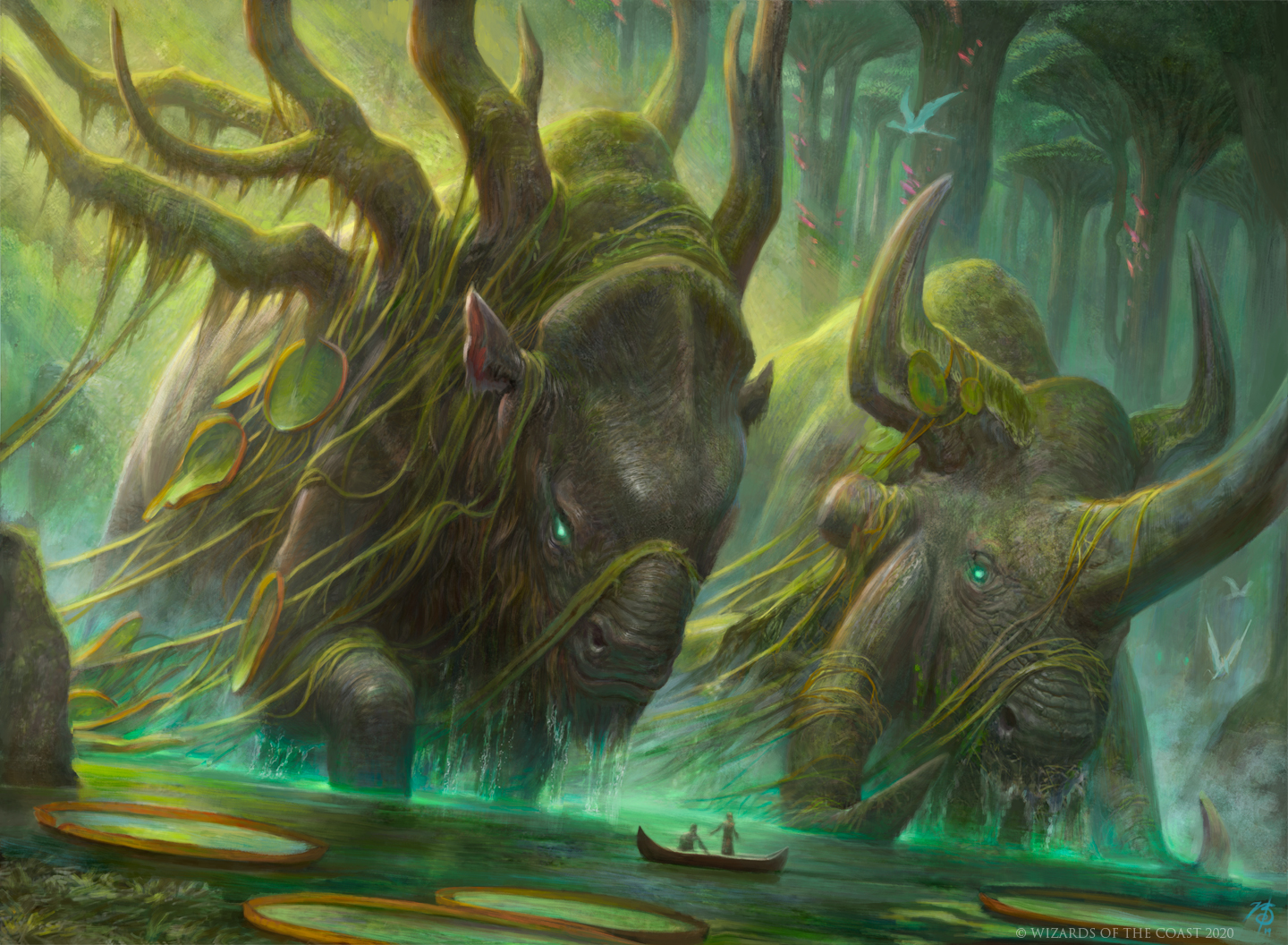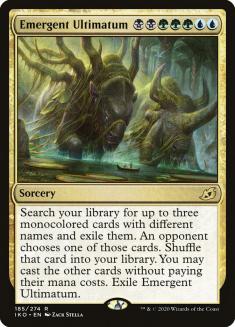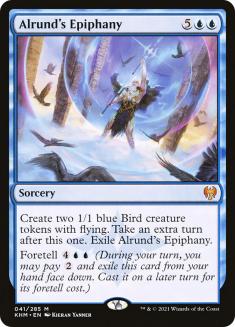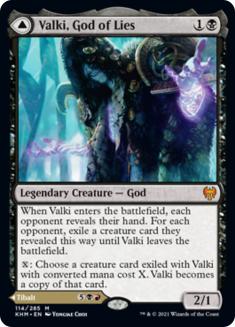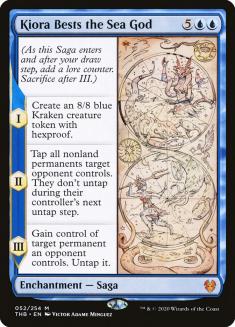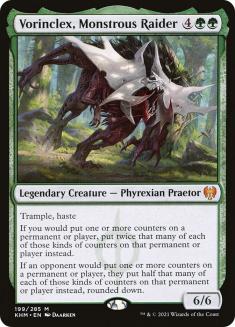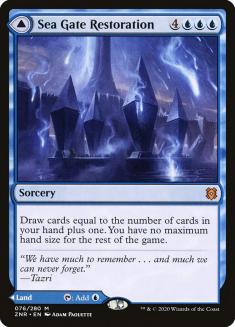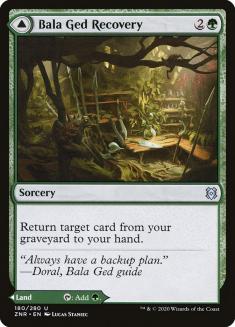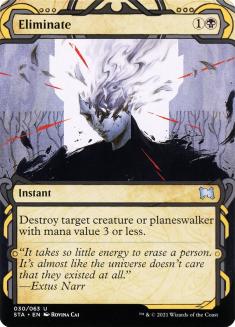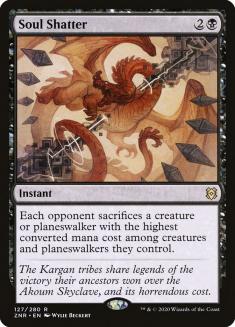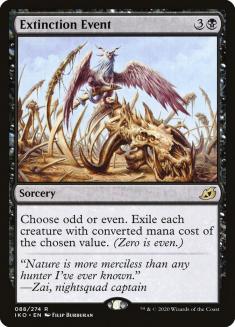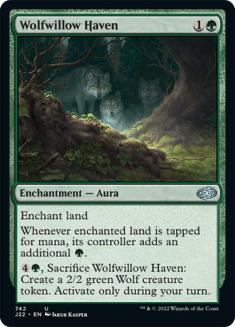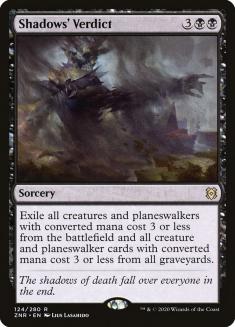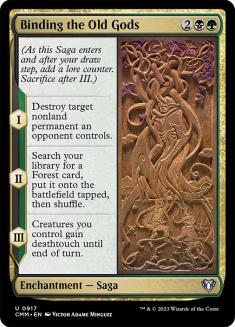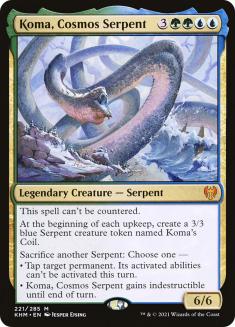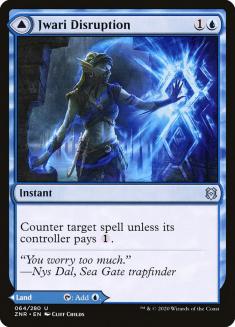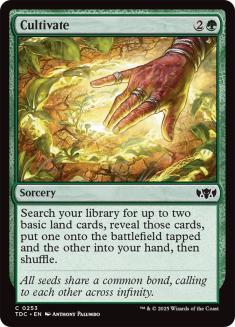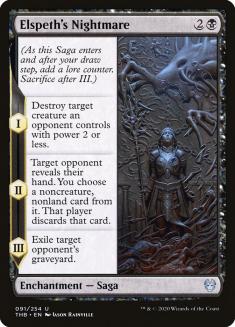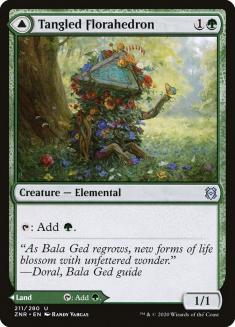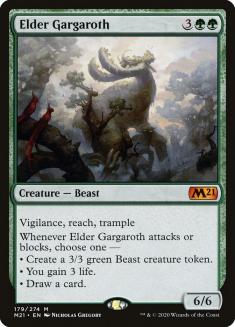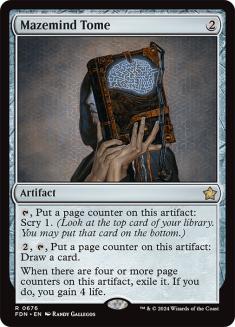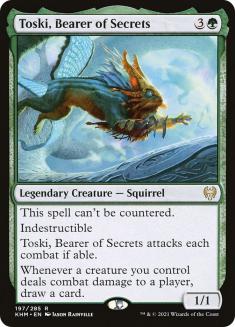Everyone is mad about Valki, God of Lies and Tibalt, Cosmic Impostor in older formats but Kaldheim Standard is secretly The Nuts™. I’ve been diving head-first into competitive Standard decks on Magic Arena, playing in a few SCG Tour Online Satellites on MTGMelee.com, and loving every minute of it. I haven’t had this much fun playing Standard in a long time and I’m starting to get those tingle jingles when it comes to deckbuilding. Once you find a strategy you like, tweaking and tuning every single slot starts to become a labor of love.
I felt that tonight (as I write this) working on this deck. It started when Tannon Grace sent me a pic of a Logan Nettles list using Emergent Ultimatum. Otherwise known as Jaberwocki, Logan is a midrange master and if he’s playing a Golgari-based deck, you should probably be playing the same Golgari-based deck. At the time of seeing the original list, I was trying out Temur Ramp and learning the hard way that red removal is bad against Lovestruck Beast. Why am I even playing red for Genesis Ultimatum? If you’re not comboing off with it, and your deck isn’t a bunch of sweet stuff like Terror of the Peaks, it starts to look a little less impressive! Hitting an Ugin, the Spirit Dragon off the top for the win is quite appealing, but what if we can do better?
“If Genesis Ultimatum isn’t winning the game when it resolves, and the red removal is worse than black removal, why am I not just playing Sultai instead of Temur?” is the question I kept asking myself. Emergent Ultimatum has some really nice piles with the inclusion of Alrund’s Epiphany and Vorinclex, Monstrous Raider. There are a lot of “options” for your opponent, but most of those options involve choosing how to lose the game. Emergent Ultimatum is incredible and you’ll be better off learning that now rather than later.
To my absolute shock (not that shocked), Sultai Ramp (Yorion) with Emergent Ultimatum won the SCG Tour Online $5K Kaldheim Qualifier on Sunday. It looked pretty similar to what I’d seen Logan Nettles brewing up, but was much more interactive and less rampy. I learned quite a bit from both builds, and saw some pitfalls in each. Some cards, like Behold the Multiverse, just didn’t make sense. That type of card works better in a flash-style setting, and is generally weak in a deck featuring mostly sorcery-speed threats.
Ramping too much means flooding out. Not ramping enough means you have too many dead cards against control or other ramp decks. It’s a tightrope to walk, but I think we might have gotten there. Cultivate is nuts for multiple reasons, but Wolfwillow Haven has been surprisingly good as well. The extra green mana is great for alleviating concerns about casting Emergent Ultimatum and it also acts like a ramp effect that only costs one mana most of the time, as you’re casting and using it on the same turn more often than not. In a deck that features so many lands that potentially enter the battlefield tapped, having a versatile ramp effect is really valuable.
After my last testing session on Arena, here’s where I am.
Creatures (4)
Lands (32)
Spells (44)

Salty Sultai 101
The general play pattern goes as follows.
Turns 2-4: Ramp and removal, depending on the situation. Protect your life total and try to use all your mana each turn. Ultimately, your goal is to make it to seven mana so you can cast Emergent Ultimatum. Using all your other resources to get to that point is your only priority.
Turns 5-9: Sweepers if necessary, but casting Emergent Ultimatum is your goal. If you draw Alrund’s Epiphany, I beg you to wait on casting it until you have some traction or you’re under duress. Casting it can bail you out of a tough situation, but it’s harder to dig yourself out of the hole if your Time Warp effect is naked. It gets so much better when you pair it with Kiora Bests the Sea God or even just a stray Yorion, Sky Nomad.
If you cast Emergent Ultimatum, here are the cards you’ll most likely assemble, though it will entirely depend on what your opponent is most afraid of.
Almost all my piles feature Alrund’s Epiphany. In a pinch, it can buy you time. When combined with a threat that costs six or more mana, it will almost always be lights-out. That’s why many combinations feature Vorinclex, Monstrous Raider, as pairing it with a planeswalker or Saga means you’re going off.
The truth of the matter is that casting your seven-mana spells isn’t that difficult. All the cheap removal helps to ensure you get into the later turns of the game. Some big threats that are versatile or multi-dimensional can create some piles that leave your opponent scratching their head. They’re unable to find a path to victory because it doesn’t exist.
If you’re a fan of Gifts Ungiven, you should spot the similarities immediately: opponent getting a “choice,” constricting those choices to make that decision irrelevant, and ultimately winning the game by casting a single card – seem familiar? Those decks in Modern tend to focus mostly on containing the opponent with discard and removal, having Gifts Ungiven act as tutor, card advantage engine, and win condition. Emergent Ultimatum is that turned up to eleven, but the cost increase certainly reflects that difference.
This is the quintessential Golgari deck. This is The Rock as Sol Malka intended. This is disruption and card draw and attrition won on the back of hard and honest work. If you have a framed picture of Tarmogoyf in your living room, chances are you’re going to like this Emergent Ultimatum deck. Go ahead and treat yo’self.
Quick Notes
- Ketria Triome is the Forest you grab from Binding the Old Gods to unlock Tibalt, Cosmic Impostor. If you don’t need an extra black mana, you should usually grab it first.
- Shadows’ Verdict is the nuts against Kroxa decks, so try to hold it until absolutely necessary. Scooping a Kroxa and a few other creatures is so nice and buys you so much time, but burning it early might result in you losing a longer game.
- Be careful how you stack Kiora Bests the Sea God; Tibalt, Cosmic Impostor; and Vorinclex, Monstrous Raider off Emergent Ultimatum. You want to make sure Vorinclex is cast last (resolves first) so the other cards enter the battlefield with extra counters.
- While we have ramp elements, I wouldn’t necessarily call this a ramp deck. I sideboard out Wolfwillow Haven all the time because we either have too much time or need to focus on interacting. In the first game, it almost acts like a wildcard. We don’t want too much removal against control and we can’t afford reactive stuff against aggro, so Wolfwillow Haven is like the bridge. Once we get to sideboard, our deck becomes a perfect blend of interaction, resource generation, and finishers.
- Koma, Cosmos Serpent doesn’t get hexproof. I learned that the hard way.
Now children, listen up and I’ll tell ya how to sideboard, and how to approach the more common matchups in Standard.
Sideboard Guide
VS Gruul/Naya Adventures
In this matchup, you’re the control deck. Use your removal spells early to buy the necessary time to cast the heavy hitters. When going through your mulligans, prioritize interaction over ramp and cheaper spells over more expensive ones. Sequence your lands so that around the fourth or fifth turn you get to start casting two spells a turn. Once you kill two creatures at once or remove a threat while doing some development work, those are the turns where you really start to pull ahead.
Out:
In:
This matchup is pretty straightforward: they cast creatures and we kill them. In true midrange fashion, our goal is to use all our two-mana removal and sweepers to clean things up so a cast Emergent Ultimatum is enough. This is a matchup as old as time, and all the players are in place. Win conditions are at a low, as we need to be more reactive and our threats aren’t sticky. We aren’t working with Thragtusk or anything.
Slow card draw effects and long-game spells aren’t as valuable here because of time constraints. Their aggressive starts can put you on the back foot, meaning you won’t get a free turn off to cast Bala Ged Recovery or Sea Gate Restoration, and as lands they’re quite mediocre. We’re playing a lot of lands and modal DFCs, so trimming one or two of your bad ones in some matchups is fine.
Of all the popular archetypes in Kaldheim Standard, this is my second-favorite matchup. Our removal lines up nicely and they aren’t quite fast enough to kill us before casting our finishers. An emphasis on Showdown of the Skalds over Embercleave means our life total isn’t in nearly as much jeopardy. We can win the long grindy games where they cast Showdown. As people try to play longer games, it just moves the needle in our direction. As long as our spells are resolving, I don’t expect to lose many games.
Matchup Grade: B+
VS Izzet Midrange❄
This matchup should be harder, but the truth is that they just don’t put much pressure on you. Emergent Ultimatum and such don’t always resolve, but you usually get ahead on mana via Cultivate and have a few answers to Goldspan Dragon, so you just have to grind through a normal control-style shell. The kicker in our favor is that they get rinsed if we resolve any of our big spells and our life total isn’t in jeopardy. They have plenty of counterspells but it gets much easier to resolve things after sideboard.
Both sides have a lot of dead cards in Game 1, but your removal isn’t as dead as theirs. They still need to stick Goldspan Dragon or Brazen Borrower to get the job done, so Heartless Act is going to be filling big shoes. Sweepers are rather weak and we get to trim on a bunch of our worse removal in favor of the “right” type of interaction. If you’re a Brad Nelson fan, this type of core shift from removal to discard/counterspells should be no surprise.
Out:
In:
As you can see, the shift is heavy, but we’re moving away from removal in favor of Duress and Mystical Dispute to interact with them in the right ways. Binding the Old Gods and Eliminate aren’t exactly dead in the first game, but they aren’t great either. Getting those and the sweepers out helps you a ton in the sideboard games.
Sequencing and baiting here are important, but one thing I can’t stress enough is that you should probably just cast your spells. The fear of a counterspell is often as strong as the counterspell itself. Waiting around for your opponent to do something means you’ll likely lose in the long term. They’re also better at using their mana at instant speed, so sitting on your hands just puts you at a disadvantage in terms of using the resources at your disposal. When it doubt, jam it out. They might not have the answer and a single resolved Kiora Bests the Sea God might be too much for them to handle.
I don’t mind playing against this deck, but we have far too many weak cards in the first game for me to feel comfortable. Goldspan Dragon plus a protection piece is terrifying, but that’s why we have to risk and jam quite often. They might just not have it. Counterspells are rather strong against Emergent Ultimatum, or any deck with seven-mana cards that don’t say “can’t be countered” on them. We operate mostly at sorcery speed as well, so finding a way to be tricky just isn’t cutting the mustard. Instead, we’re going to attack them with uncounterable cards like Shark Typhoon and Koma, Cosmos Serpent.
Matchup Grade: C+
VS Rakdos Midrange
When in doubt, trade. We can win long games, and they don’t really have a big clock or a way to stop you from resolving your payoff spells. Your cheap removal is great here, but one thing you’ll notice is how absurd Binding the Old Gods is. Taking our their three-mana creature and finding a land on the following turn is, quite frankly, absurd. I love it love it love it and this matchup is pure proof on why we’re playing four.
Out:
In:
They’ll likely be hitting you with a ton of discard, so ramp effects that don’t gain any card advantage are out. Jwari Disruption is particularly mediocre here because their average casting cost is so low, and their whole jam is casting more than one spell a turn once they hit their stride. Cards that generate some amount of in-game currency and replace themselves are also desirable. While Shark Typhoon isn’t broken, it’s certainly fine for three or four mana to generate a body and cycle. The difference in winning and losing the matchup is often a single blocker or removal spell.
Your MVP is Shadows’ Verdict. You’ll search for it off Emergent Ultimatum more than expected and your opponent will usually be forced to give it to you. Valki is pretty poor against anyone playing Bonecrusher Giant and I recommend trimming at least one in those matchups, as naturally drawing it is usually pretty bad in the early turns. Any matchup where you need more answers than threats is a matchup where trimming a Valki is fine.
Overall, I think this matchup is great. The Shadows’ Verdict draws will usually buy enough time to win the game one way or another. Their lack of a true clock just gives you too much time and they have no real way of beating a resolved Emergent Ultimatum without having established an extremely good battlefield.
Matchup Grade: A
VS Dimir Rogues
They play a ton of cheap threats, cheap counters, and cheap bursts of card draw. This is a nightmare matchup. This is the matchup that every Dimir Rogues opponent dreams about. As long as they know what they’re doing, you’ll be going in at a distinct disadvantage. I don’t know how to salvage it and I’m not confident there’s anything to be done about it.
We’re already weak to counters in general because our deck is full of expensive payoffs. While those will occasionally win the game when they resolve, and are essentially “must-counters” for the most part, getting one to stick can be rather tricky against a Dimir Rogues opponent.
On top of the natural play patterns putting you in the dumpster, their mill subtheme is actually disastrous for a tutor-heavy deck. Pretty often an errant Ruin Crab or Soaring Thought-Thief will strip you off your Alrund’s Epiphany or Kiora Bests the Sea God. There’s not a lot else to say.
Out:
In:
Ramp is mediocre here because tapping out in the early turns means you can’t interact with their flash-speed threats. You need to be ready and willing to keep all their creatures from sticking longer than half a turn. It’s obnoxious, but it’s a play pattern that tends to get results against these tempo-style decks. If you can keep their threat off the table, you can live long enough to eventually start casting your payoff spells. Eventually, one of those might resolve and win you the game, but all the payoff cards in the world won’t matter if you’re getting pecked to death by a swarm of tiny Rogues.
We’re basically turning into a different deck and crossing our fingers that it’s good enough. We can win games. Hell, we can even win matches, but I always try to play it straight with y’all. This is our worst matchup and the reason is built into the structure of our deck and has very little to do with how we play or sideboard. Because of that, we’re taking a pretty huge gamble in sideboard games.
Matchup Grade: D
VS Mono-Green Aggro
This is another matchup where Shadows’ Verdict absolutely hoses our opponent. Those two decks are the reason why we’re playing three maindeck. While Extinction Event is cheaper, Shadows’ Verdict just hits the nail on the head. These new Mono-Green Aggro decks beat down pretty hard, but all our black removal lines up nicely. I was struggling quite a bit with this style of deck when I played Temur Ramp last weekend, but their creatures just don’t hit the same when we have Eliminate and Heartless Act instead of Fire Prophecy.
They can overwhelm you by getting The Great Henge online before you reach Emergent Ultimatum mana, but those games should be few and far between. Your best bet is to continuously pop their larger creatures in an attempt to delay The Great Henge for as long as possible.
Out:
In:
This matchup is similar to Gruul and Naya Adventures. They play a lot of the same creatures and approach the matchup in a similar way. They’re also vulnerable to the same cards. Ramp is actually fine here, as casting a single Emergent Ultimatum should be enough to give you a serious advantage, and their clock isn’t exactly menacing. Cultivate into Shadows’ Verdict might be the nail in the coffin, but timing is everything. Make sure you play your tapped lands early and often when you don’t need the mana, even if it means Jwari Disruption becomes a land instead of a spell. It’s better to have a smoothed out draw than having a bit of insurance against flooding.
Overall, this matchup is pretty good. I’d like to play against it often. They have fewer haste creatures and fewer card advantage engines these days, so your life total shouldn’t be in too much danger on turns where you tap out. Each of their threats is better on average than Naya Adventures, but most still trade one-for-one.
Matchup Grade: A-
A Living Decklist
When it comes to midrange strategies, having the ability to mold your decklist to fight the current metagame is important. I will likely be changing stuff and trying new cards every single time I pick up the deck. For now, I love the current configuration, but a rise in popularity in Dimir Rogues can easily challenge us if Sultai Ramp takes a dominant role in the format. And thus, a rotating metagame begins!
Cards of Interest
The winning decklist from last weekend’s SCG Tour $5K Kaldheim Qualifier played three copies of Elspeth’s Nightmare, so maybe I’m underestimating just how good that card is in the current format. Three is a lot to ask for a removal spell that only kills creatures that cost less mana.
A creature that dies to cheap removal. I’ve completely dismissed Tangled Florahedron after it was hit with Stomp for the third time. Hard pass.
A singleton Ugin, the Spirit Dragon or a dramatic shift toward three or four copies in the maindeck could be the next iteration. Most of the Cultivate decks I’ve played in the past were centered around Ugin, but currently Emergent Ultimatum has an edge. A singleton could be good for guaranteeing some Ultimatum piles answer the entire battlefield, and it’s quite a good topdeck if you have eight mana. It’s high on my list for consideration.
I found myself never wanting to bring in Negate. Against other blue decks, you need to slam and jam. Your spells are pretty expensive, so I’d rather my interaction/disruption be cheaper and proactive. Duress and Mystical Dispute do enough work that I think they’re just good enough. That leaves you a few more slots for big threats like Koma, Cosmos Serpent so you can actually win games instead of drawing Negate when your opponent already has Goldspan Dragon on the battlefield.
I’m a big fan of Elder Gargaroth. I expect I’ll have one maindeck and one sideboard by next week. It’s solid against all the creature-based decks and randomly dodges a lot of cheap removal. It can steal games you have no business winning because it just puts up a huge brick wall that the opponent can’t attack into or block efficiently.
More permanents for Yorion to blink might be fine. Mazemind Tome is certainly solid but I’d rather my card advantage spells or things that work with Yorion to be a bit less mana intensive to accrue value. Scry is fine, but I’d much rather be able to play another virtual copy of Omen of the Sea.
Speaking of Yorion, I’ve gotten a lot of people asking if we should be playing more copies in our maindeck. My response so far has been like clockwork: we’re not really a Yorion deck. We’re an Emergent Ultimatum deck that actually wants to play more than 60 cards to dilute the possibility of drawing your payoff cards. You also get a free flying monster that can blink Omen of the Sea. You could build the deck to do exactly that, but this build does not reflect that ideology.
This one is pretty mediocre outside of infinitely chaining Alrund’s Epiphany. If you wanna jam four copies of Alrund’s Epiphany, running a few Toski, Bearer of Secrets is probably fine. Otherwise, we’re just not playing enough ways to trigger the draw ability.
Moving Forward
In the next few weeks, expect all eyes to be on Kaldheim Standard as the format develops. Right now, Modern and Legacy are getting hammered by the interaction between cascade and Valki (appropriate, if you ask me). I expect we’ll get errata soon, so I’ll be putting all of my energy into Kaldheim Standard until things settle down over there. If that happens, expect this list to change too, as Emergent Ultimatum grabbing Valki and casting Tibalt is a “trick” that everyone should know about by now.
This is the first Standard format I can remember in quite a while that has five or more viable decks. The gameplay is great, and you can gain some major edges in deckbuilding and sideboarding. I’ve enjoyed finding cool sequences with Yorion like blinking Wolfwillow Haven to generate an extra mana so you can cast Heartless Act during your end step!
I’ve enjoyed playing Magic, and that’s not something I could say a few months ago. I’ll be gearing up and streaming a lot more over the next few months, so if you’d like to see the strides I make on this deck or just enjoy watching some fun games of Magic, come check out my channel (and hit that follow button!).
See you soon!

